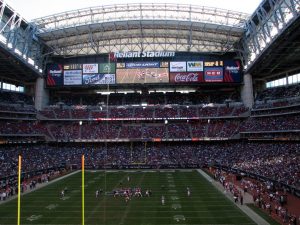Now that we know who’s playing in Super Bowl LI, speculation can begin about the other game time competition: commercial break warfare.

The 51st Super Bowl will take place in Houston, TX at NRG Stadium (formerly Reliant Stadium).
While players of the Patriots and Falcons will practice with intensity in anticipation of the big game, the world’s more renowned companies and brands are putting in just as many hours developing their marketing tactics and advertising campaigns to air during the worldwide event. As they should: Variety reported that a 30-second spot will cost these companies a cool $5 million. With only 30 seconds to make an impact at such a steep price, the pressure is on to stand out from competitors.
Many remember Budweiser’s “Puppy Love” in 2014, Volkswagen’s “Star Wars: The Force” of 2011, and even Cindy Crawford’s Pepsi ad of 1992 (that’s 25 years ago, in case you wanted to feel old).
So what does it take to stand out, and what should we expect to see this year? Look no further than Dr. Ayalla A. Ruvio, assistant professor of marketing at the Broad College of Business and resident expert in applied consumer behavior, for answers.

Ayalla A. Ruvio, assistant professor of marketing
Do you foresee any brands/companies using new marketing tactics in 2017?
As long as the Super Bowl will be broadcast on TV, it will be leveraged by companies in the form of traditional commercials and marketing tactics, at least by the companies with deep enough pockets to cover this relatively expensive (but often worthwhile) medium. However, all companies this year aim to develop creative content and social marketing strategies that go beyond traditional methods and TV, in order to facilitate their consumer’s engagement and to foster long-term relationships with them. Even big companies with generous advertising budgets enjoy when their ads “go viral,” giving the ad an extended play. And of course, creative content and social strategies are especially attractive to smaller companies that do not have big marketing budgets, but still wish to connect with their consumers effectively.
What brands consistently “get it right” by staying on top of trends – and what, in your eyes, gives them staying power?
Successful brands are the ones that understand their consumers and offer a meaningful value to them, which is a message that goes beyond “buy this product.” These brands tell a compelling story that resonate with their consumers and do it in a consistent way across media channels. Budweiser and Procter & Gamble, for example, focus on creating an emotional connection with their consumers. Doritos has successfully managed to reach out to their consumers in a funny and entertaining way. These brands foster deep lasting relationships with their consumer by leveraging different events, such as the Super Bowl.
What challenges to companies face advertising during such a high-profile event?
The challenge most companies will face will be to break through this crowded space in an effective way. Creativity will be key to these marketing efforts, which is where we’ll see a greater shift to social media and engagement. The Super Bowl offers a great opportunity for companies to reach out to a wider audience, and start a dialog that can (and should) continue long after this event ends. People talk about the ads Monday morning at work, more than they talk about the game!




